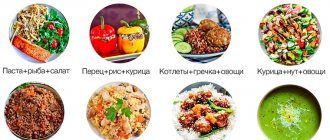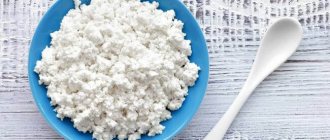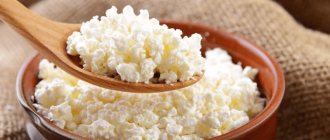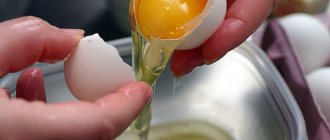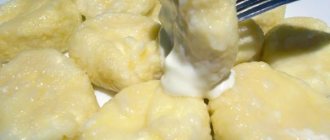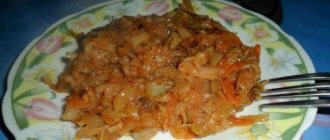Syrniki
Ingredients:
- 150 g soft cottage cheese in a briquette;
- 2 tbsp. l. rice flour;
- 1 egg;
- 1 tsp. butter or coconut oil;
- sweetener (optional).
Cooking method:
- Mix cottage cheese with egg and sifted flour. Add sweetener if necessary.
- Heat coconut oil or butter in a water bath. Add to the dough and mix again.
- Spoon the dough onto a non-stick frying pan. To cover with a lid.
- When the cheesecakes are browned, turn them over to the other side and fry until done with the lid open.
You can serve cheesecakes with sour cream, honey, melted dark chocolate, and fresh berries.
How to store cottage cheese
It is important not only to prepare, but also to store cottage cheese correctly. All dairy products are a favorable environment for the development and reproduction of harmful bacteria, so they must be stored at a temperature no higher than 6 degrees. The best container for preserving the freshness of cottage cheese would be metal dishes with an enameled surface or glass containers with a tight lid.
How to store cottage cheese
It is not recommended to store cottage cheese in close proximity to products that have strong, pronounced odors. Since dairy products belong to the category of perishable goods, you should always pay attention to the expiration date on the label of store-bought cottage cheese. After opening the package, its shelf life is up to 3 days.
You can store cottage cheese in the freezer; this storage period can be up to three months.
It is worth remembering that only dry product can be frozen, without excess moisture and whey. Interesting: in ancient times, clay vessels were used to preserve the dairy product, and the curd was covered with a layer of butter on top, thanks to which it was kept fresh for a long time and did not lose its beneficial properties.
Undoubtedly, cottage cheese should be present in every person’s diet, and the methods for preparing dietary dishes from it are quite varied and simple. This excellent product contains easily digestible protein, which promotes weight loss.
But it is always important to listen to yourself, since everyone’s taste preferences are very individual and depend on the internal state of the body or the presence of chronic diseases.
For some, eating cottage cheese only for breakfast is suitable, others feel great after snacking on a dish of cottage cheese for dinner, and some are ready to eat it several times a day. It is worth remembering that everything is good in moderation and cottage cheese is not a panacea for weight loss. But including cottage cheese dishes in the diet, with additional physical activity, can give the desired result very quickly.
Casserole
Required ingredients:
- 250 g cottage cheese;
- 2 eggs;
- 100 ml of cream or milk (if the cottage cheese is dry, it is better to use milk, if it is watery, use cream);
- vanillin;
- sweetener;
- butter.
Cooking method:
- Separate the yolks from the whites.
- Combine cottage cheese, milk (cream), sweetener, vanillin and yolks (the easiest way to do this is with an immersion blender). The output should be a thick mass, the consistency of thick sour cream.
- In a separate bowl, beat the whites until stiff peaks form. Add them to other ingredients.
- Grease the mold with butter, pour the curd mixture into it and smooth it out.
- Bake for 30 minutes in an oven preheated to 160–170 °C.
The casserole is served to the table after it has cooled completely. The dish goes well with hot drinks - tea, coffee, chicory.
Glazed cheese curds
Required Products:
- 500 g low-fat cottage cheese;
- 100 g dark chocolate;
- 300 g cherries;
- 1 tsp. agar-agar;
- 2.5 tbsp. l. fructose;
- vanillin.
Cooking method:
- Combine cottage cheese, fructose, vanillin. Mix thoroughly or beat with a blender.
- Melt the chocolate in the microwave or in a water bath. Stir regularly (otherwise it may overheat and curdle). Coat the inside of the muffin tins with chocolate and place in the freezer.
- Grind the berries using a blender.
- Take out the molds and make sure the chocolate has set. Fill them with cottage cheese one third or half, put berry puree and cover with curd mass. Place in the freezer for 10 minutes.
- Coat the top with chocolate and put it back in the refrigerator. In 15 minutes the cheesecakes will be ready.
The delicacy can be stored in the refrigerator and used as a PP dessert.
How to choose cottage cheese
To achieve long-term weight loss, it is important to learn to eat healthy, not eat less. And the main part of proper and healthy nutrition is quality products. Therefore, when choosing them, you need to be careful and try to buy only proven products.
Store-bought cottage cheese
Today, dairy producers offer their products to suit every taste. When choosing a product on store shelves, it is important to carefully study the labels, check the production date and expiration date of the cottage cheese. According to European quality standards, if a product is made from natural milk, the word must be indicated on the label - cottage cheese, non-curd dessert or cottage cheese.
Store-bought cottage cheese
For a high-quality fermented milk product, the optimal shelf life is no more than 72 hours.
The longer the shelf life, the greater the likelihood that the product has been subjected to additional heat treatments and, as a result, has lost most of its beneficial substances and properties.
Often, to add flavor to curd products and extend shelf life, manufacturers additionally enrich cheese products with flavors, dyes, vegetable fats and food additives.
This exponentially increases the amount of sugar, carbohydrates, harmful chemicals and calories, which is completely unacceptable for maintaining a healthy diet and diet. Some dairy brands include fermented or live cultures in their curds, which are beneficial for gut health.
Homemade cottage cheese
Dietary dishes made from homemade cottage cheese are considered the most healthy. This process is quite lengthy, but as a result you can get a high-quality homemade product that will contain more fat-soluble vitamins and healthy fatty acids than a store-bought one.
Homemade cottage cheese
An undeniable advantage here will be the ability to choose the required calorie content of cottage cheese, due to the fat content of milk, without impurities, dyes, without starch or fiber. Such a product will have a low glycemic index, in which the digestion and absorption of nutrients occurs slowly, gradually, so the feeling of hunger subsides for a longer time.
You can buy good cottage cheese at food and specialized markets, where you always have the opportunity to try the product. The color of store-bought cottage cheese can vary from white to creamy shades; the pieces should be dense and juicy, moderately moist and moderately dry.
Good cottage cheese is cut easily, without difficulty and does not fall apart. If the cottage cheese tastes sour or sweet, it means it contains acid or sugar.
The yellow, rich color does not indicate the high fat content of the cottage cheese, but that there is a dye present. You can leave some purchased cottage cheese open in the air for 9-10 hours; if it begins to sour, it means it is a natural product. Slightly acidified cottage cheese can be used in recipes that involve heat treatment of foods.
Pancakes
Curd pancakes turn out soft and fluffy. They taste like cheesecakes, but have a completely different consistency.
Ingredients needed to prepare the dish:
- 150 g cottage cheese;
- 100 g sour cream 15% fat;
- 30–50 g rice flour (the amount of product can be adjusted depending on the moisture content of the curd);
- 2 eggs;
- sweetener;
- vanillin;
- 1 tsp. baking powder.
Cooking method:
- Combine cottage cheese, eggs, sweetener and sour cream. Mix with a blender.
- Add sifted flour, vanillin, baking powder. To stir thoroughly.
- If the dough is too liquid, you can add a little more flour. If, on the contrary, it is thick, you should dilute it with water or milk.
- Heat the frying pan. If the coating is not non-stick, grease it with vegetable oil.
- Spoon the dough into the pan. Fry covered for 5 minutes on each side.
What cottage cheese contains, calorie content
A balanced diet is important for the stable functioning of the human body. Cottage cheese is an excellent source of calcium, B complex vitamins and vitamin A. It is high in protein, some healthy saturated fat and other important nutrients such as phosphorus, iron, magnesium, calcium and selenium.
Protein alone makes up more than 70% of the calories in cottage cheese. Milk contains two types of proteins - casein and whey. Casein is 80% milk protein, and whey is 20%. During the process of making cottage cheese, the casein protein is separated from the whey and makes up the majority of the curd product.
It is absorbed slowly, thereby providing the body with the full amount of essential amino acids necessary for the growth and restoration of muscle tissue and cells. In addition, natural fermented milk products contain beneficial microorganisms such as lactobacilli; they take an active part in the functioning of the human gastrointestinal tract.
Cottage cheese, its composition, beneficial properties
Dietary dishes made from cottage cheese are well accepted by the body throughout the day. However, according to the recommendations of nutritionists, it is better to eat them in the morning, or before 17:00 in the evening. The daily dose is determined depending on individual preferences, but not more than 100 grams of cottage cheese per serving and at least 2-3 times a week.
It is important to remember that you can consume a natural product every day, but in small portions.
Cottage cheese is a nutritious and healthy product for people of different age categories, because:
- Fermented milk product is one of the good sources of vitamins and probiotics, improves digestion, prevents indigestion, heartburn symptoms, helps eliminate irritable bowel syndromes and constipation;
- Magnesium in cottage cheese activates various enzymes in the body and supports the functioning of the immune system;
- Phosphorus and calcium compounds form the basis of bone tissue and strong teeth;
- Phosphorus takes an active part in the process of detoxification of the body and the removal of toxins and harmful substances;
- Selenium increases antioxidant protection of the circulatory system, prevents the development of diseases of the cardiovascular system, and fights the aging process;
- High protein content ensures a long-lasting feeling of fullness, which leads to reduced calorie intake and weight loss;
- Helps normalize metabolism in the body and lowers bad cholesterol levels;
- Serves as an additional source of amino acids that take part in the formation of enzymes, hormones, and muscles.
- The fats in cottage cheese provide the body with the necessary energy and vitality.
Calorie content of dairy product
Cottage cheese may differ depending on production technologies; it can have different levels of fat content, with artificial additional enrichment of calcium and probiotics, and can be made from different types of milk: goat, cow, sheep and even camel. The higher the fat content of the milk, the higher the fat content of the cottage cheese.
Calorie content of dairy product
Well, for dietary nutrition, the most beneficial is considered to be a fermented milk product based on cow's milk of medium or low fat content. This low-calorie cottage cheese is easier to digest by the body, but at the same time contains enough useful nutrients.
For example, 1 tbsp. without a slide (200 g.) of cottage cheese with a low content of 1% milk fat, provides the body with:
- calories: 163;
- protein: 28 g;
- carbohydrates: 6.1 g;
- fats: 2.3 g;
- phosphorus: 30% daily intake;
- sodium: 30% of normal;
- selenium: 29%;
- vitamin B12: 24% daily intake;
- riboflavin: 22%;
- calcium: 14.0%;
- folate (folic acid): 7.0% DV.
In smaller doses, it also contains vitamins B1, B3 and B6, as well as vitamin A, iron, magnesium, potassium, zinc and copper. For the daily norm of an adult, 100–150 grams of fermented milk product will be enough.
A comparative calorie table calculated per 100 grams of product will help you determine the nutritional value of cottage cheese of different fat contents:
| Fat content of cottage cheese, % | Calorie content, kcal | Squirrels, gr. | Fats, gr. | Carbohydrates, gr. |
| cottage cheese up to 2% (low fat) | 103,0 | 18,0 | 2,0 | 3,3 |
| cottage cheese 5% (classic) | 121,0 | 17,2 | 5,0 | 1,8 |
| cottage cheese 9% (bold) | 159,0 | 16,7 | 9,0 | 2,0 |
| cottage cheese up to 23% (fat) | 232,0 | 14,0 | 18,0 | 2,8 |
Nutritional disadvantages of curd product
Dairy products are the main food source of calcium and protein. The calcium in cottage cheese is in a bioavailable form and is easily absorbed due to the presence of lactose and vitamin A. But, like any food, excessive consumption of cottage cheese can have a negative effect on the body.
It can cause digestive problems, especially if you are lactose intolerant, allergic reactions, or if you are allergic to dairy products or milk protein. Homemade fermented milk products contain high amounts of sodium. Full-fat cottage cheese contains 819 mg of sodium per 200 g. product, while its low-fat counterpart contains 746 mg of sodium.
The daily dose for an adult is 1500 mg of sodium. Therefore, those who need to limit their salt intake should reduce their servings of cottage cheese to a minimum or buy a fermented version of the commercially produced product that is low in sodium or without salt.
Cupcakes
Ingredients:
- 200–220 g low-fat cottage cheese (up to 5%);
- 50–70 g oatmeal;
- 1 egg;
- vanillin;
- cocoa powder;
- water;
- berries, fruits, nuts or raisins for filling.
Cooking method:
- Soak the oatmeal in a little water and let it soak.
- Combine cottage cheese and egg. To stir thoroughly.
- Add oatmeal, cocoa and vanillin to the curd mixture.
- Divide between muffin tins so that each is one-third full (batter will rise during baking).
- Press filling into the middle of each cupcake. It could be a nut, raisin, a piece of fruit, fresh or frozen berry.
- Bake for 20–35 minutes in an oven preheated to 180°C. Check readiness with a toothpick.
Cookie
For cooking you will need the following products:
- 200 g cottage cheese;
- 200 g oatmeal;
- 1 egg;
- 50 g raisins;
- 1 tsp. baking powder;
- ground cinnamon, vanillin;
- vegetable oil.
Cooking method:
- Wash and dry the raisins. Grind if necessary.
- Combine cottage cheese with oatmeal. Add baking powder, raisins, egg, vanilla and cinnamon. Mix thoroughly and set aside for 15 minutes.
- At this time, cover a baking sheet with baking paper and grease with vegetable oil. Preheat the oven to 180°C.
- Wet your hands with cold water. Roll out small balls of dough, place on a baking sheet and flatten slightly until they are shaped like round oatmeal cookies.
- Cook for 25 minutes.
Before serving the cookies, they need to be cooled. The next day it becomes even more delicious.
Mechanism of weight loss
Cottage cheese can be the main and additional product for fasting programs, mono and long-term diets. Athletes include it in their diet on training days to speed up the process of building muscle mass while actively burning fat. All this is due to its beneficial properties:
- helps maintain muscle mass;
- accelerates metabolism;
- enriches the body with calcium;
- satisfies hunger for a long time;
- improves digestion;
- is a diuretic, eliminating excess fluid and swelling;
- provides the body with additional energy;
- fights compulsive overeating, as it has a beneficial effect on the nervous system: calms, improves mood, relieves irritability;
- has lipotropic properties, accelerating fat metabolism.
Nutritionists say: even just by regularly adding it to your diet, you can keep your figure in good shape without any diets.
About the name. Translated from Old Church Slavonic, “cottage cheese” means “solid milk.”
Cheesecake
To prepare a healthy dessert you will need:
- 5 cans of soft cottage cheese;
- 4 eggs;
- 6 tbsp. l. sour cream;
- 1.5 cups rice flour;
- sweetener.
Cooking method:
- Combine eggs, flour, sour cream, sweetener. Mix until you get a soft dough that sticks to your hands.
- Spread the mixture over the bottom of the baking dish. Form the sides.
- Prepare the filling from soft cottage cheese and sweetener. Place inside the mold and smooth out.
- Bake for 50 minutes at 180°C.
- Decorate with fruits or berries. Cool at room temperature and then in the refrigerator.
Unsweetened recipes
There are many unsweetened PP recipes with cottage cheese that help satisfy the feeling of hunger for a long time and diversify your usual diet. We recommend recipes for chicken breasts with cottage cheese in the oven, methods for preparing fish cutlets with cottage cheese, and dietary cottage cheese puddings. You can also make your own protein shakes from cottage cheese, recipes for which you will find in this article.
Buckwheat casserole with cottage cheese is good for a healthy breakfast, and bell peppers stuffed with cottage cheese as an appetizer for a meat dish.
